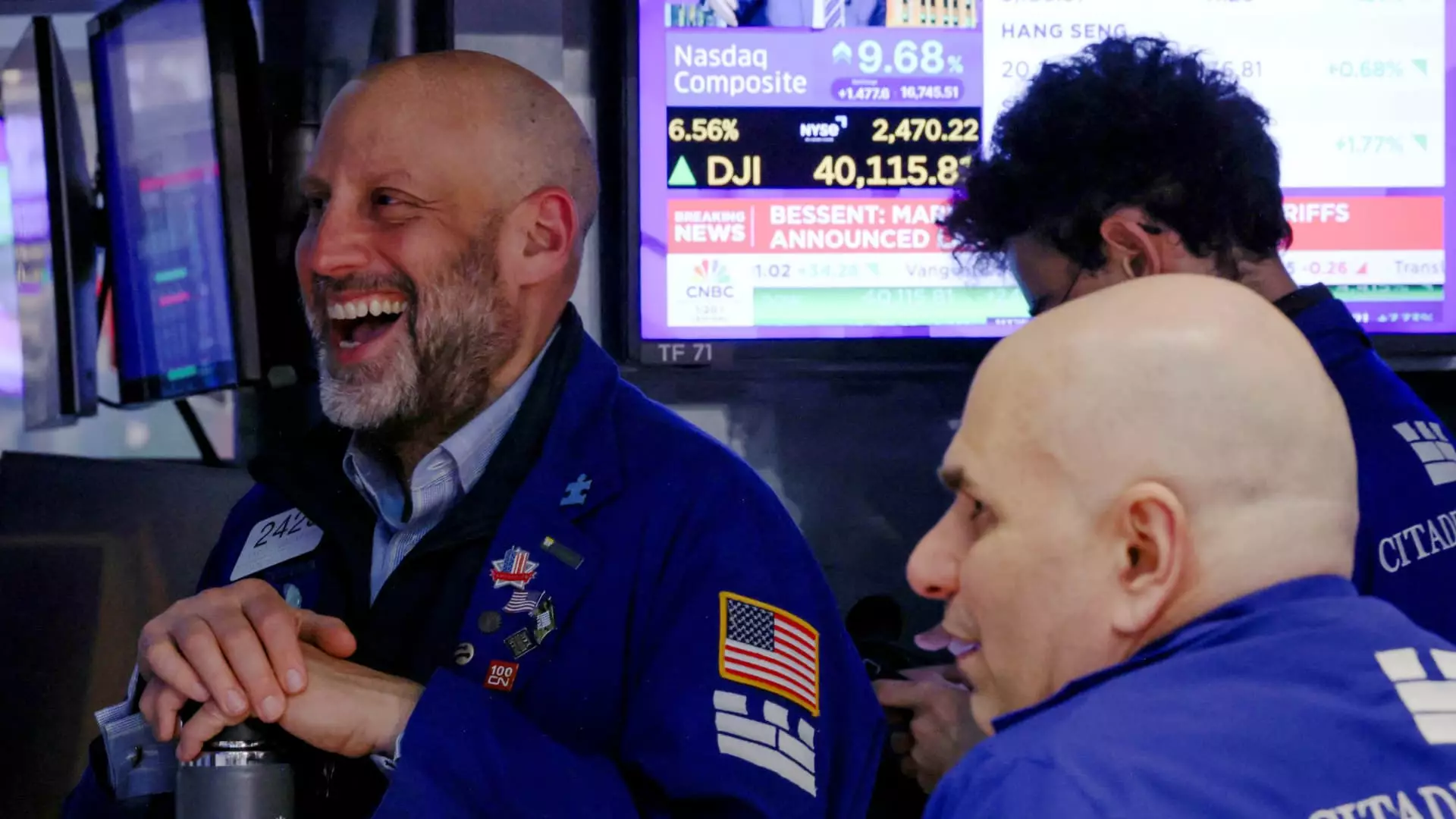The financial markets experienced an astonishing rebound following President Donald Trump’s announcement to pause certain reciprocal tariffs, a development that sent stocks soaring to heights unseen in recent years. The Dow Jones Industrial Average recorded an eye-popping 3,028-point surge, a staggering 8% increase—the most significant jump since 2020. Similarly, the Nasdaq Composite skyrocketed by 12.4%, marking its highest one-day gain since 2001, while the S&P 500 surged 9.3%, on track for its most substantial gain in five years. This euphoric uptick begs an essential question: is this recovery genuine or merely a fleeting illusion created by shifting political winds?
The President’s proclamation on Truth Social was met with immediate market enthusiasm. In the midst of pervasive anxiety regarding an escalating trade war, investors were desperate for any sign of relief. The notion that tariffs were being lowered—if only for a brief period—energized a market that had been experiencing severe turmoil, primarily due to uncertainty over the effects of ongoing trade tensions. However, beneath the surface, this optimism may obscure a more complex reality.
Illusions of Stability Amid Tariff Complexity
On closer scrutiny, the euphoria surrounding the tariffs’ suspension seems a bit hollow. Trump’s announcement included a critical detail: while tariffs on all countries except for China would revert to a 10% baseline during the negotiation period, the duties imposed on China would skyrocket to 125%. Is this truly a sign of progress or just an invitation for further conflict?
The excitement from investors following the announcement raises concerns about the durability of the resulting gains. Stocks like Apple and Nvidia surged by over 11% and 13%, respectively, while Tesla enjoyed an extraordinary rise, climbing over 19%. Yet, Adam Crisafulli, founder of Vital Knowledge, warns that this sudden spike is not indicative of a stable market. “Given how depressed stock prices and sentiment had become, the 90-day pause is sparking a violent rebound,” he noted, capturing the ambivalence many feel. How can we take this rally seriously when significant tariffs are concurrently raised on a nation that serves as a cornerstone of global trade?
Market Reactions: A Study of Fear and Speculation
The preceding days before Trump’s announcement were marked by panic, with the market falling dramatically—a frantic response to what investors perceived as an escalating tit-for-tat tariff war. In just four trading sessions, the Dow plunged over 4,500 points, representing a loss of 12% for the S&P 500 and a staggering retreat of over 13% for the Nasdaq Composite. The volatility and uncertainty raised eyebrows, making the announcement of a temporary reprieve feel like a momentary spark in a darkening storm.
Furthermore, the markets’ reaction underscores the fragile state of investor sentiment. Trump himself described investors as “a little bit yippy,” indicating that fear and speculation were deeply influencing the investment landscape. This volatile emotional backdrop skews perceptions of stability and growth, and it raises an alarming question: are investors betting on a mirage rather than a sustainable economic environment?
Moreover, political analysts and economists alike have pointed out that a fundamental flaw remains in viewing these temporary pauses as win-win situations. Sam Stovall, a chief investment strategist at CFRA Research, cautioned that while this could lead to a short-term rally, “I would not assume that the bottom has been put in place.” His wise words resonate amidst the euphoric noise: relying on temporary measures can lead to a false sense of security that may ultimately leave investors exposed to more significant challenges.
A Cautious Path Ahead
Ultimately, markets are swayed not just by numbers but by sentiment, a reflection of broader economic health and political stability. The recent surge presents a façade of recovery that could quickly dissolve as the reality of the underlying issues returns to fore. Understanding that tariffs are not disappearing allows for a more nuanced view of the market’s trajectory. It compels us to look beyond momentary gains and wallow in the chaos of uncertainty that characterizes the current economic climate.
With the continuation of heightened tariffs on key trade partners like China, the question that looms is whether this breathing period will be a harbinger of actual change or just another chapter in an unending cycle of economic anxiety. In an age shaped by protectionism and populism, volatile swings in market sentiment will likely become the norm, and only those prepared for the long haul will weather the storms ahead.


Leave a Reply